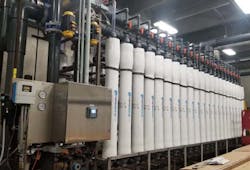Randall Community Water District upgrades drinking water system with Nanostone Membranes
WALTHAM, MA, JULY 27, 2018 – Randall Community Water District, along with Nanostone Water, has announced their successful retrofit with Nanostone Water ceramic membranes. Randall Community Water District is responsible for providing drinking water to Randall, SD and surrounding areas. Four years ago, they installed a polymeric ultrafiltration system as an upgrade, at their Platte, SD facility, to produce 2.7 million gallons per day (426 m3/hr) of water during the peak flow summer period. The plant was designed to de-rate during the winter, low demand months. Randall demand profile has, however, been increasing recently, and it was decided to expand the system to increase the winter production rate, but at the same time, Randall wanted to address higher-than-expected cleaning chemical needs of the polymeric ultrafiltration system.
In May 2018, after a successful pilot, the polymeric ultrafiltration plant was retrofit with Nanostone's CM-151™ ceramic membrane. The CM-151 module is designed to easily replace a pressurized polymeric module. "We were able to remove the existing modules, install the Nanostone product, change the programming and get the system started-up in about a week", said Scott Pick, General Manager of RCWD. "We couldn't have asked for a smoother start-up."
"The Nanostone CM-151 was designed to be able to retrofit into systems that were designed with an open platform. The RCWD retrofit was our largest single skid retrofit to date, and we appreciate the partnership of RCWD and their team" said Bill Musiak, Vice President of Sales for Nanostone Water.
About Nanostone Water
The CM-151TM ceramic membrane from Nanostone Water was launched in February 2017, and is a unique high surface area pressurized ultrafiltration monolith style membrane module with improved permeate flow efficiency and lower energy consumption versus currently available ceramic membranes. The form factor enables replacement of existing PUF hollow fiber modules with minimal system modifications. Together, with the improved energy efficiency, the high surface area and unique segmented construction drastically reduces cost of ownership, making Nanostone's ceramic UF module competitive with polymeric UF/MF systems. Headquartered in Waltham, Massachusetts, the company has ceramic manufacturing operations in Halberstadt, Germany. (www.nanostone.com)
